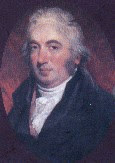The Sphere February 12, 1955 – page 268
STATE AID FOR A REGENCY MANSION[i]:
Ashdown, in Sussex, Receives a government
Grant for Urgent Structural Repairs
AN HISTORIC SUSSEX MANSION WHICH HAS A LINK WITH THE UNITED
STATES: Ashdown House[ii],
near Forest Row, was built in the late eighteenth century by Benjamin Latrobe
the architect responsible for part of the Capitol, in Washington [iii].
Among the latest recipients of Government grants for urgent
repairs is Ashdown House, in Sussex. It
is one of the two works in this country[iv]
of Benjamin Latrobe [v],
whose name is better known in the United States. He finished Ashdown[vi]
in 1791, five years before he emigrated.
It is a fine example of early Regency.
It consists of a square main block which the architect added to a partly-seventeenth-century
gabled building. One of its best
features is the porch of stone columns with Ionic capitals. Inside the entrance an elegant staircase
leads to a lobby, with columns, on the first floor. Ashdown is now a preparatory school for boys [vii]
[viii].
Financial help is being given towards eradicating dry-rot
and other repairs. Ashdown benefits by
the scheme administered by the Minister of Works under the terms of the
Historic Buildings and Ancient Monuments Act of 1953. Each year he is allowed £250,000 to allocate to historic
buildings in Britain for repairs or maintenance. In making the grants he is advised by three
committees, for England, Wales and Scotland respectively, whose members are
public figures or architectural experts.
So far the grand total of buildings thus assisted is 114 at a cost of £285,
000.
[photo captions] Below –
A GRACEFUL EXAMPLE OF A REGENCY INTERIOR: Columns form a
lobby on the first-floor landing of Ashdown House. Above them is a plaster dome with coloured
coffers. Below the landing the porch
projects into the entrance hall.
Benjamin Latrobe, the architect, emigrated to America in 1796 five years
after he had completed this building.
The Government grant is towards the cost of repairs and the eradication
of dry-rot. Ashdown is now a preparatory
school for boys.
On left –
THE COLUMNED PORCH: The front entrance is semi-circular,
with stone columns with Ionic capitals and enriched bases of terra-cotta. Under its roof is a domed ceiling, with
finely-decorated reliefs.
THE EXTERIOR AND INTERIOR OF ASHDOWN HOUSE: On left –
Latrobe’s masterpiece is in the center.
He added it to a seventeenth-century gabled stone building, which is
behind. The chapel is on the left of the
picture. On right—The entrance hall and
staircase are among the best interior features.
Latrobe became surveyor of public buildings to the American Government
in 1803. Besides the south wing of the
Capital, he designed the cathedral in Baltimore.
[i]
This is a misnomer. The Regency period started in 1811, twenty years after
Ashdown House was built.
[ii] British
Listed Buildings: http://www.britishlistedbuildings.co.uk/en-296058-ashdown-house-school-forest-row-east-sus
[iii]
Read more about Latrobe’s work on the Capitol here: http://www.aoc.gov/architect-of-the-capitol/benjamin-henry-latrobe
[iv]
Hammerwood Park, near East Grinstead is the other private house built by
Latrobe. See: http://www.hammerwood.mistral.co.uk/
[v] Benjamin Henry Boneval Latrobe (May
1, 1764 – September 3, 1820- Wikipedia Biography: http://en.wikipedia.org/wiki/Benjamin_Henry_Latrobe
[vi]
Ashdown House was built by Latrobe for John Trayton Fuller (1743-1811) John ”Mad
Jack” Fuller’s first cousin.
[vii]
Ashdown House preparatory school official website is here:
http://www.ashdownhouse.co.uk/
[viii]
Unfortunately, Ashdown House School has been mired by allegations of neglect
and abuse see: http://www.dailymail.co.uk/news/article-2688344/Former-headmaster-prep-school-attended-Boris-Johnson-Damian-Lewis-arrested-suspicion-child-sex-offences.html



No comments:
Post a Comment